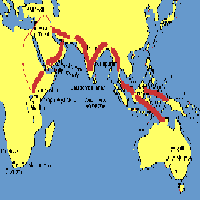参考文献
References1. Sugden A, Pennisi E(2006) When to Go, Where to Stop. Science 313:775.

2. Forster P, Matsumura S(2005) Evolution. Did early humans go north or south?Science 308:965-6.

3. Macaulay V, Hill C, Achilli A, Rengo C, Clarke D, Meehan W, Blackburn J, Semino O, Scozzari R, Cruciani F, Taha A, Shaari NK, Raja JM, Ismail P, Zainuddin Z, Goodwin W, Bulbeck D, Bandelt HJ, Oppenheimer S, Torroni A, Richards M (2005) Single, rapid coastal settlement of Asia revealed by analysis of complete mitochondrial genomes. Science 308:1034-6.

4. Field JS, Lahr MM(2005) Assessment of the southern dispersal: GIS-based analyses of potential routes at oxygen isotope stage 4. J World Prehist 19(1)1-45.
[journal link]
5. Lahr MM, Foley R(1994) Multiple dispersals and modern human origins. Evol. Anthropol 3:48-60.

6. Foley R, Lahr MM (1997) Mode 3 technologies and the evolution of modern humans. Camb Archaeol J 7 (1): 3-36.
[ISI]7. Lahr MM, Foley RA(1998) Towards a theory of modern human origins: geography, demography, and diversity in recent human evolution. Am J Phys Anthropol Suppl 27:137-76.

8. Forster P(2004) Ice Ages and the mitochondrial DNA chronology of human dispersals: a review.Philos Trans R Soc Lond B Biol Sci 29;359:255-64.

9. Kivisild T, Shen P, Wall DP, Do B, Sung R, Davis K, Passarino G, Underhill PA, Scharfe C, Torroni A, Scozzari R, Modiano D, Coppa A, de Knijff P, Feldman M, Cavalli-Sforza LL, Oefner PJ(2006) The role of selection in the evolution of human mitochondrial genomes.Genetics 172(1):373-87.

10. Smith MA, Tacon PSC, Curnoe D, Thorne A, Mellars P (2007) Human Dispersal into Australasia . Science 315:597-598.

11. Li H (2004) Yellow washed Brown down: A tale of Modern Human in the Far East. Journal of National Dr. Sun Yat-sen Memorial Hall 14:164-180.
[PDF]  COM.on C.A.1:e2/4-6 Online
published on Mar. 31, 2007.
COM.on C.A.1:e2/4-6 Online
published on Mar. 31, 2007. COM.on C.A.1:e2/4-6 Online
published on Mar. 31, 2007.
COM.on C.A.1:e2/4-6 Online
published on Mar. 31, 2007.